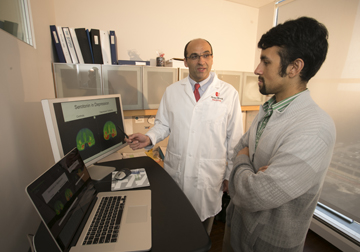Ramin Parsey, MD, PhD
HUNTING FOR BIOMARKERS TO PREDICT RESPONSE TO ANTIDEPRESSANTS
Ramin Parsey is Professor and Chair of the Department of Psychiatry and Director of Positron Emission Tomography (PET) Research. A leader in developing National Institutes of Health (NIH) and industry-sponsored imaging and clinical protocols, Dr. Parsey’s research in PET and MRI (Magnetic Resonance Imaging) data acquisition and analysis has had continuous NIH funding for more than a decade. He is lead investigator on nine current grants and wrote and served as principal or co-investigator on five Investigational New Drug (IND) applications. He developed an advanced, patent-pending image processing method for the diagnosis of Alzheimer’s disease and has developed novel radiotracers for PET imaging. Board-certified in Psychiatry, Dr. Parsey—in addition to teaching, research, and administrative duties—continues his clinical practice at Stony Brook, diagnosing and treating patients with depression and bipolar disorder.
Why did you select your field?
My father was a family doctor, and I could not help appreciating the joy and satisfaction he experienced every day. My brother is also a physician. As a young man, I was certain that I was not going to medical school, but as I matured, I came to think it was the right thing to do. I considered cardiology and neurology, but decided on psychiatry after spending an hour with a patient in a state hospital with chronic schizophrenia. It is a fascinatingly complex disorder, and each and every patient has their unique story.
Why choose to work at Stony Brook? What is the opportunity here?
I was excited by the program laid out in the Medical Center’s strategic plan—with its emphasis on imaging and the neurosciences—and by the potential for major breakthroughs in medicine and imaging when the MART (Medical and Research Translation) building opens and the cyclotron becomes operational. There are tremendous opportunities here at Stony Brook. For me, one of the most attractive is the chance for collaborative research with world-class experts like Dennis Choi [Chair of the Department of Neurology and Director of the Institute for Advanced Neurosciences] and Lorna Role [Professor and Chair of the Department of Neurobiology and Behavior and Co-Director of the Institute for Advanced Neurosciences]. These opportunities for important research increased significantly with the installation of the new hybrid imaging system in the Lisa and Robert Lourie Imaging Suite. The ability to simultaneously record PET and MRI data enables us to compare structure and function in ways we could not do before.
What is the most rewarding aspect of your job?
My job is highly rewarding at many levels. I enjoy working with a team of researchers, including interns and postdocs, who are enthusiastically pursuing important questions. Preparing the next generation of psychiatrists to take on the challenges of mental health care is deeply gratifying. But perhaps the most rewarding element, as well as the most challenging, is transforming the Department of Psychiatry to make it a leader in clinical care and scientific research.
What breakthrough would you most like to make?
More than anything else, I would like to discover a biological marker that predicts response to antidepressants. Right now, treating depression is a matter of trial and error—we prescribe a medication and wait for to six weeks to see if it works. If we could develop a series of measures that would predict who will respond best to which medications, we could have much better success. But before we can develop such a profile, we need to understand the biology. This is where imaging comes in.
What might your field look like in the year 2020?
No one knows what neuroscience will look like in 2020 because there is no way to predict the major discoveries that lie ahead of us. I am fairly certain that the scientific advances of the future will occur by pooling our expertise and resources; modern science and technology are far too complex for any one individual to grasp. I expect that the field of psychiatry will develop in concert with developments in imaging and genetics. Our clinical practice will change dramatically over the next six years as federal and state health care initiatives take hold. We expect psychiatry to become more closely integrated with the other medical specialties.
If you could send one message to the community about your field, what would it be?
Mental illness, like other diseases, is the result of biological abnormalities. It is not the result of choice but of biological processes outside the individual’s control. If we can get this message across, we hope the stigma associated with depression and other mental illnesses will be reduced, resulting in more people coming for treatment.
Do you have a trait you are willing to share, as a window into your personality?
I speak fast and assume a lot.
DR. PARSEY...
|  Dr. Parsey looks at brain images with MD/PhD student Raja Pillai Dr. Parsey looks at brain images with MD/PhD student Raja Pillai |


